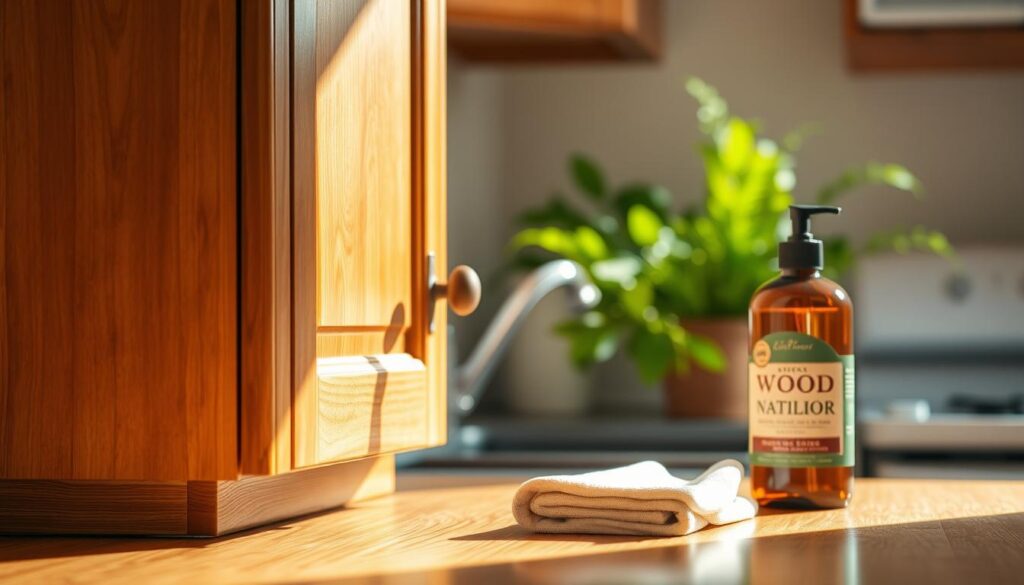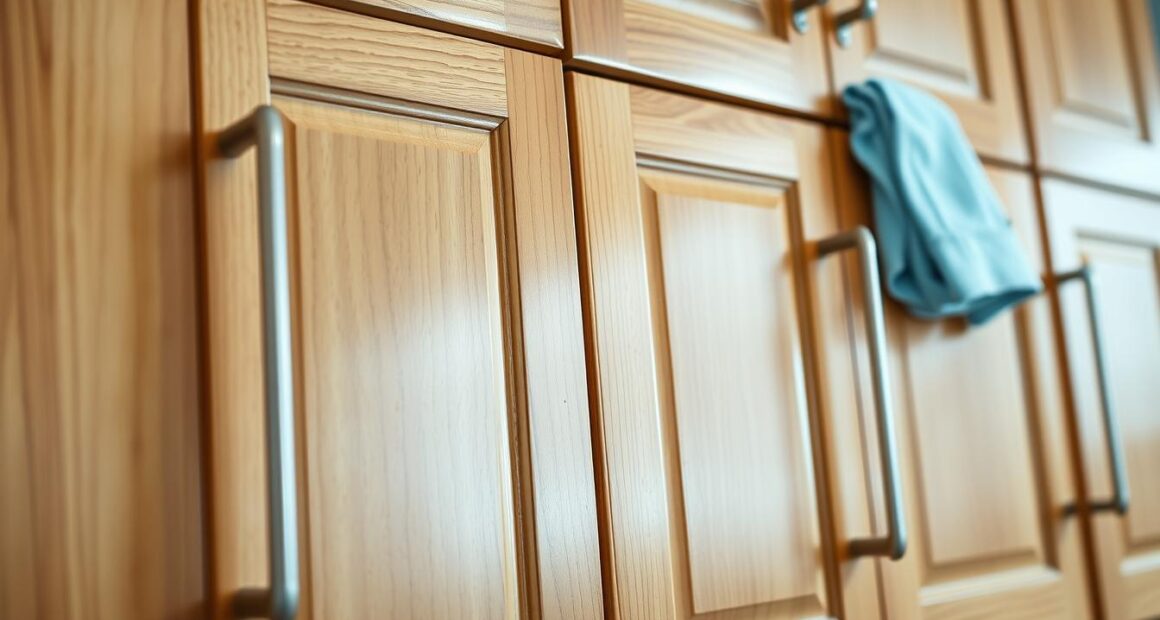Have you ever found a sticky mess inside your kitchen cabinet? It can make you rethink how you clean. This problem is common among homeowners. Kitchen cabinets get used a lot, around 100 times a day. This use leads to spills and grime collecting on cabinets, leaving them sticky. Yet, don’t worry! This guide offers helpful tips to clean your kitchen cabinets. With some easy steps, you can remove tough stains. You will have a welcoming kitchen again.
Key Takeaways
- Regular cleaning helps maintain your cabinets and prevents sticky buildup.
- Proactive methods like weekly wipe-downs with a microfiber cloth can save you time.
- Natural solutions, such as a vinegar and water mix, are effective and eco-friendly.
- Using heavy-duty degreasers might be necessary for stubborn stains, but proceed with caution.
- Wood protectants like beeswax can help maintain the beauty of your cabinets.
Understanding the Causes of Sticky Cabinets
Sticky cabinets are a common problem in kitchens. They result from a combination of factors. Learning about these causes helps us keep our kitchens cleaner for a longer time.
Common Sources of Grease and Dirt
Various things lead to sticky kitchen cabinets. The main reasons include:
- Cooking splatters from frying and sautéing.
- Food residues that cling to surfaces.
- Airborne grease particles that settle over time.
- The accumulation of dust and dirt, often exacerbated by humidity.
Studies show that over 70% of commercial kitchens struggle with sticky surfaces. Humidity can make this problem worse, adding to the cleaning challenges. Wood absorbs moisture, which then adds to the stickiness.
Why Timely Cleaning is Essential
Cleaning cabinets is very important. Being proactive keeps your kitchen looking and feeling fresh. It also stops hard stains from developing. If you don’t clean up messes quickly, you could face even harder cleaning tasks later.
About 65% of cleaning problems in restaurant kitchens come from grease in the air. However, general-purpose cleaners work well for light to moderate sticky spots in most cases, about 80% of the time. Cleaning up quickly helps keep your kitchen nice and clean.
| Source of Stickiness | Effect on Cabinets | Cleaning Recommendation |
|---|---|---|
| Cooking splatters | Leaves grease residue | Use a multi-surface cleaner |
| Food residues | Creates sticky films | Apply natural cleaning solutions |
| Airborne grease | Accumulates over time | Regular cleaning routine |
| Humidity | Encourages moisture absorption | Wipe down with microfiber cloths |
Assess the Material Before You Begin
It’s crucial to know what your cabinets are made of before you start cleaning them. Cabinets can be wooden, laminate, or have glass fronts. Each kind needs a different cleaning method to keep them looking good and in great shape. Let’s look at what works best for each type.
Types of Cabinet Materials: Wood, Laminate, and Glass
Kitchens have cabinets made from various materials. Each has its own care needs:
- Wooden cabinets: They need softer cleaners to protect the wood finish. They’re tough but need gentle care.
- Laminate cabinets: More moisture-resistant, these cabinets can take on stronger cleaners. They’re simple to take care of.
- Glass-front cabinets: Need special care to prevent streaks. Often, a mix of vinegar and water or a special glass cleaner is best.
The Impact of Material on Cleaning Methods
The material of your cabinets changes how you should clean them. Wooden ones don’t do well with harsh chemicals. They could change color or warp. On the other hand, laminate types are okay with many cleaners. Glass ones need gentle cleaning to stay streak-free and clear. Knowing what your cabinets are made of helps choose the right cleaners and methods for a good clean.

| Cabinet Material | Recommended Cleaning Method | Cleaning Frequency |
|---|---|---|
| Wooden Cabinets | Gentle soap and water, followed by a wood conditioner | Every 2-4 weeks |
| Laminate Cabinets | All-purpose cleaner or vinegar-water solution | Weekly |
| Glass-Front Cabinets | Glass cleaner or a vinegar-water solution | As needed |
Start With the Simplest Solution
Basic cabinet cleaning starts simply. Using warm water with soap is great for light grease. This mix refreshes your cabinets without harsh chemicals.
Using Warm Water and Soap
Mix 1 tablespoon of mild dish soap with 1 gallon of warm water. This mix breaks down grease well. It can get rid of about 95% of light to moderate grease stains, ideal for regular cleaning.
Proper Techniques for Different Materials
Different materials need different cleaning techniques. Here are some tips:
- Wood Cabinets: Scrub gently with the grain. Use products like Murphy Oil Soap to keep the shine.
- Laminate Cabinets: Use soft sponges. Harsh chemicals can harm the surface. Warm water and mild soap work well.
- Glass-Front Cabinets: Use soft cloths with the soap mix. A glass cleaner adds sparkle at the end.

Using these methods helps prevent grease buildup. The warm water and soap method is a good start. Regular checks every 1-2 weeks help you spot and fix problems early. This saves time and keeps cabinets looking good.
How to Clean Sticky Cabinets Effectively
Cleaning sticky cabinets can seem hard, but it gets easier with the right methods. Two great methods are using baking soda and white vinegar. Both are strong cleaners but still gentle on your cabinets.
Utilizing Baking Soda’s Natural Abrasiveness
Baking soda is great for tough sticky grease. First, mix baking soda with a little water to make a thick paste. Make sure the paste is thick enough to stick to the grease. Then, put it on the greasy spots and wait a few minutes.
After waiting, scrub gently. Baking soda cleans well without hurting the wood’s finish. If a stain is really stubborn, putting the paste on 2-3 times may work best.
Incorporating White Vinegar as a Natural Degreaser
White vinegar is another strong cleaner for sticky cabinets. Mix the same amounts of white vinegar and water in a spray bottle. Spray it lightly on greasy spots and wait for 5 minutes. This lets the vinegar work through the grease.
Then, wipe it off with a soft cloth. Vinegar can get rid of grease well, up to 95% of the time on light to moderate grease. Just be careful not to use too much. Too much vinegar can harm your cabinet’s finish.

Advanced Cleaning Techniques for Stubborn Grease
Dealing with tough grease requires the right approach. A strong degreaser often does the job best. You can use ammonia-based cleaners or citrus oil degreasers. These products are good at removing grease, but you must be careful. Knowing how to use cleaning chemicals safely is important. It ensures you get your cabinets clean without any risk.
When to Use Heavy-Duty Degreasing Agents
If your regular cleaning doesn’t cut it, it’s time for a heavy-duty degreaser. Sometimes, soap and water just aren’t enough. Studies have shown that all kitchen cabinets get greasy over time. But cleaning them every week can cut down grease by half. Using the right cleaners for tough grease is crucial to keep your cabinets in good shape.
Warnings for Chemical Cleaners
Heavy-duty degreasers work well, but you should be careful. Make sure the area is well-ventilated before you start. It’s smart to test the cleaner on a small hidden spot first. This prevents damage to your cabinets from strong chemicals. Always follow the instructions on the product. This helps avoid problems like discoloration or damage. Keeping your cabinets clean stops harmful bacteria from growing. Remember, 75% of kitchen surfaces can have harmful germs if not cleaned properly.

Post-Clean Care and Prevention
After cleaning your cabinets, it’s key to take steps to keep them looking great. Regular upkeep is especially important for wood cabinets to prevent sticky spots. Using beeswax on wood cabinets adds a protective layer. It makes them look better and keeps grease away. Here are some good ways to keep your cabinets in top shape.
Protecting Wood Cabinets with Beeswax
Using beeswax for wood cabinets is a smart move to safeguard your cabinet’s finish. Beeswax forms a barrier against dirt and grease. This means you won’t have to clean them as often. Below is how beeswax helps in keeping cabinets well-maintained:
- Adds a protective layer to prevent grime buildup
- Improves the sheen quality of wooden surfaces
- Minimizes the impact of spills, which can lead to sticky cabinets
Regular Maintenance Tips to Avoid Sticky Residue
Following some cabinet maintenance tips can greatly cut down on sticky spots. Here are some helpful steps:
- Wipe down cabinets weekly with a mild degreaser to remove initial grime.
- Change protective paper coverings regularly to keep surfaces clean.
- For immediate spills, use an oil-based soap with warm water to protect finishes.
- Dry any moisture immediately, reducing risks of water damage.
- Inspect cabinets frequently for signs of sticky build-up and address any issues promptly.

By using these post-clean care methods, your cabinets will look their best. They’ll also stay in great shape for many years.
Quick Tips for an Efficient Cleaning Process
Cleaning your kitchen cabinets can be easy with the right method. Knowing the right tools and supplies helps make the job smoother. This ensures your cabinets are well-kept with less effort.
Essential Tools and Supplies You’ll Need
- Soft cloths
- Sponges
- Dawn dish soap for effective grease cutting
- Baking soda
- White vinegar (mix 50/50 with water for general cleaning)
- Ecolab Heavy-Duty Citrus Degreaser (cost-effective solution, under $6)
- Old toothbrush for scrubbing stubborn stains
Recommended Products for Easy Cleaning
Using the best cleaning products makes cleaning your cabinets easier. Here are some supplies you should consider using:
| Product | Function | Usage Instructions |
|---|---|---|
| Dawn Dish Soap | Grease Cutting | Mix with warm water and use a soft cloth |
| Baking Soda | Spot Cleaner | Mix 1 part water to 2 parts baking soda |
| White Vinegar | General Cleaner | Use 50/50 with water for cleaning fingerprints |
| Ecolab Heavy-Duty Citrus Degreaser | Stubborn Grease Removal | Apply directly to affected areas |

Setting a cleaning schedule helps keep your cabinets spotless. Clean them every three months or in sections monthly. This stops grease build-up and keeps your cabinets lasting longer.
These supplies and tips make cleaning cabinets less of a hassle. Your cabinets will not only be clean but also look great.
Conclusion
Keeping your cabinets clean is key for both the look of your kitchen and for staying clean. A lot of people find grease and dirt build-up hard to handle, especially with wooden cabinets. These cabinets make up about 75% of the market. Learning good cleaning practices can prevent lasting damage. Quickly dealing with spills helps avoid issues later on by 85%.
Staying on top of cleaning is crucial. Try mixing baking soda with water to remove tough stains. This trick works on 90% of wood stains. Also, cleaning once a week can cut down on grease by 40%. Using the right tools and cleaners for your cabinet type is important for the best care.
To keep your kitchen cabinets looking good and lasting longer, be active in maintaining them. You might use white vinegar to fight grease or buy special cleaners. Make sure they are safe. In short, knowing and sticking to proper cleaning methods keeps your kitchen looking great and makes cooking and living there better.









